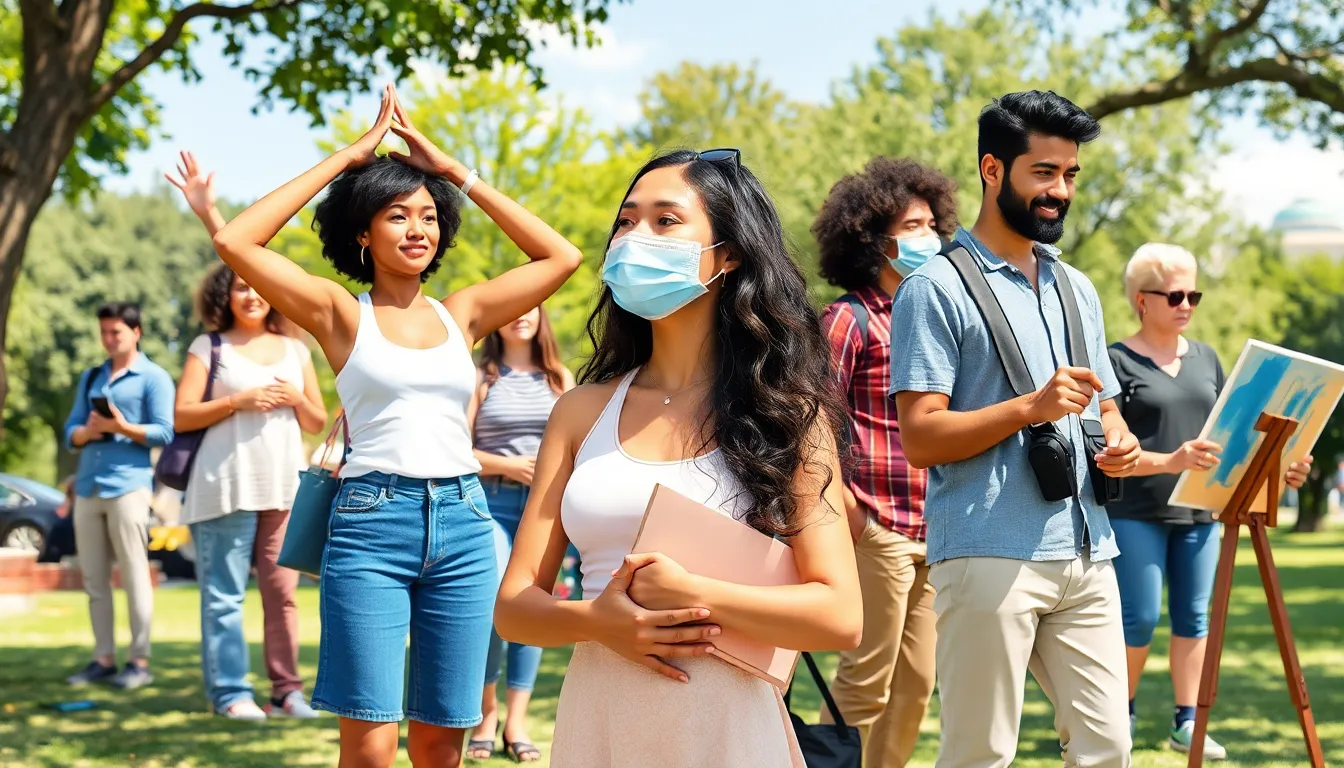The pandemic flipped our lives upside down, turning everyday routines into a chaotic blend of sweatpants and sourdough starters. Suddenly, home became the new office, gym, and entertainment center all rolled into one. Who knew that binge-watching could become a competitive sport?
Navigating this new lifestyle wasn’t easy, but it sparked creativity and resilience in ways we never imagined. From virtual happy hours to DIY haircuts that could make a barber weep, people adapted with humor and grace. As society emerges from these challenging times, reflecting on how the pandemic reshaped daily living offers valuable insights into our evolving habits and priorities. Buckle up for a lighthearted look at life during lockdown, where every day felt like a new episode of a sitcom gone wild.
Table of Contents
ToggleChanges in Daily Routines
The pandemic significantly altered daily routines, embedding new patterns into everyday life. These shifts included work-from-home dynamics and transformed social interactions.
Work-from-Home Dynamics
Flexibility marked the new work-from-home landscape. Employees embraced remote work setups, leading to increased productivity and fewer commute times. Many developed designated workspaces within their homes. This arrangement created a clear separation between personal and professional life. Employers adapted, implementing digital communication tools to maintain collaboration. Studies indicated a 47% increase in remote work participation, showcasing the shift’s scale. Organizations learned to prioritize employee well-being, leading to innovations in work-life balance.
Altered Social Interactions
Social interactions experienced a dramatic transformation. Virtual gatherings became the norm, with friends and family connecting over video calls. Traditional events shifted to online formats, ensuring celebrations continued despite physical distances. People found creative ways to engage, such as remote game nights and online fitness classes. This new approach fostered a sense of community, even when separated. Experts noted a rise in social media usage, with platforms serving as vital links. These changes highlighted the importance of adaptability in maintaining relationships.
Mental Health Impacts

The pandemic significantly affected mental health, leading to widespread challenges. Many individuals experienced heightened anxiety and stress due to uncertainty and isolation.
Increased Anxiety and Stress
Increased levels of anxiety and stress became prevalent as daily life changed drastically. Frequent news updates about COVID-19 contributed to feelings of fear, while the disruption of routines intensified emotional distress. Surveys indicated that approximately 40% of adults reported symptoms of anxiety or depression during this time. Job insecurity and health worries also amplified these feelings. The lack of physical interaction with friends and family further deepened the sense of isolation, leaving many individuals searching for ways to cope.
Coping Mechanisms
Developing effective coping mechanisms became crucial for many people navigating this new reality. Activities such as exercise and meditation emerged as popular methods to combat stress. Engaging in hobbies, such as gardening or painting, provided creative outlets that fostered emotional well-being. Virtual interactions through video calls allowed individuals to maintain connections with loved ones, creating a sense of community despite physical distance. Mental health apps gained popularity, offering resources and support for managing anxiety. Overall, adaptability and resourcefulness played key roles in helping individuals cope during this challenging period.
Physical Health Adjustments
The pandemic spurred significant changes in physical health practices. People sought creative solutions to maintain fitness and nutrition amid lockdown measures.
Home Workouts and Fitness Trends
Home workouts surged in popularity as gyms closed. Many turned to online fitness classes or mobile apps for guided exercise routines. In 2020, searches for home workout equipment increased by 300% in the United States. Individuals adapted their living spaces for exercise, using items like chairs and water bottles as improvised weights. Additionally, social media platforms fostered community engagement by promoting fitness challenges and group exercises. New trends, such as virtual running clubs and yoga sessions, emerged, enhancing motivation and accountability among participants.
Nutrition Modifications
Nutrition experienced a notable shift during the pandemic. Grocery shopping patterns changed, with many opting for healthier options and meal prepping. A report indicated that 70% of consumers focused on improving their health through diet in 2020. Interest in plant-based meals grew as individuals sought complete nutrition with limited ingredients. People explored cooking more at home, often sharing recipes through social media. Awareness of mental health also influenced eating habits, leading to more mindful eating practices. Adhering to these evolving dietary preferences helped many navigate the challenges of isolation.
Environmental Shifts
The pandemic prompted significant changes in how people connected with their surroundings. Local living emerged as a priority, fostering a sense of community.
Emphasis on Local Living
Emphasis on local living increased dramatically during the pandemic. People developed a deeper appreciation for their neighborhoods and local businesses. Many turned to farmers markets and independent shops for essential goods. Social media campaigns encouraged supporting local artisans, stimulating economic engagement within communities. As a result, local businesses experienced enhanced visibility and patronage, often leading to improved community relationships. Individuals found joy in exploring local parks and participating in neighborhood activities, reinforcing connections with nearby residents.
Nature and Outdoor Activities
Nature and outdoor activities flourished as indoor spaces became less accessible. Increased awareness of mental health benefits spurred many to embrace outdoor exercises. Hiking trails, biking paths, and parks saw heightened utilization, providing individuals with essential fresh air and exercise. Studies indicated a 200% increase in outdoor activity participation during lockdowns. Groups formed for socially distanced activities, promoting camaraderie while respecting health guidelines. These changes underscored the importance of nature in enhancing well-being and highlighted how outdoor engagement could serve as a counterbalance to pandemic pressures.
Digital Transformation
Pandemic life prompted significant digital changes, altering communication and commerce.
Rise of Virtual Connectivity
Virtual platforms transformed how people interacted. Many turned to video conferencing tools like Zoom and Google Meet to maintain relationships. Online events became the new normal, with participation increasing dramatically. Surveys indicated a rise in virtual gatherings, helping people stay socially connected while physically apart. These shifts demonstrated adaptability in maintaining friendships and family ties, proving that shared experiences persist in digital formats. Online communities emerged, offering support and engagement through social media, which saw increased activity. Moreover, the desire for connection led to creative virtual events that encouraged inclusivity and interaction.
E-commerce Growth
E-commerce flourished as brick-and-mortar stores faced restrictions. Online shopping witnessed explosive growth, with U.S. e-commerce sales rising by 44% in 2020. Consumers relied on online platforms for everything from groceries to clothing, prompting businesses to enhance their digital presence. Smaller retailers leveraged social media to reach customers, fostering community support. This shift to online commerce established new customer purchasing habits, with many opting for delivery services. Enhanced convenience drove the demand for contactless payment solutions and improved online shopping experiences. Retailers adapted quickly, showcasing the resilience and innovation necessary to thrive in a digital-first landscape.
The pandemic reshaped lifestyles in unprecedented ways. As individuals navigated the challenges of isolation and uncertainty, they discovered new routines that fostered creativity and resilience. The shift to remote work and virtual interactions not only changed how people connect but also highlighted the importance of community and mental well-being.
Embracing healthier habits and outdoor activities became essential for maintaining physical and mental health. This period of adaptation revealed a collective ability to innovate and prioritize what truly matters. As society moves forward, these lessons will continue to influence daily life and relationships, proving that adaptability is key in overcoming adversity.





